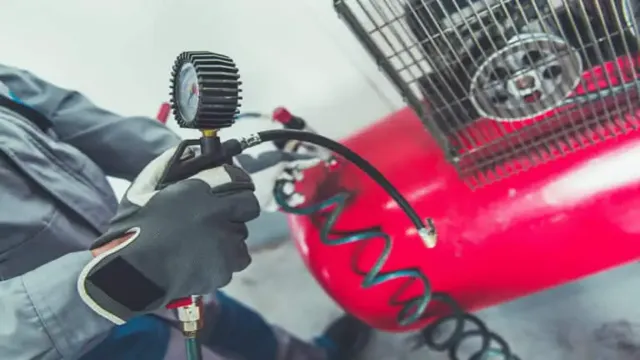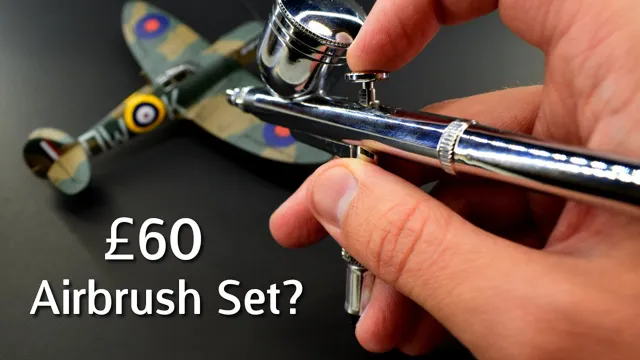Can I Use Any Air Compressor with an Airbrush? Understanding the Compatibility Factors

If you’re new to airbrushing, it can be overwhelming to navigate the world of compressors. With so many models and features, it’s hard to know which one is compatible with your airbrush. But fear not: in this blog post, we’ll break down everything you need to know about airbrush compressor compatibility.
We’ll discuss the key factors to consider when choosing a compressor, whether you’re a beginner or a seasoned pro. By the end of this article, you’ll have a clear understanding of how to choose the right compressor for your airbrush and avoid any compatibility issues.
Air Compressor Basics
You may be wondering whether any air compressor can be used with an airbrush. The short answer is no – not all air compressors are suitable for use with an airbrush. It all comes down to the specific requirements of the airbrush you are using.
Airbrushes require a steady, even flow of air with a consistent pressure, which not all air compressors are capable of producing. Ideally, you should use an air compressor that has a tank and a regulator, so you can adjust the air pressure to meet the requirements of your airbrush. It’s important to do your research before purchasing an air compressor for your airbrush, and always check the specifications provided by the manufacturer to ensure compatibility.
By doing so, you’ll be able to create beautifully detailed artwork without any hiccups.
Understanding Air Pressure and Airbrushing
When it comes to airbrushing, the air compressor is the backbone of the entire process. This device essentially pressurizes the air that is used to create unique designs and patterns on various surfaces. There are a few important things to keep in mind when it comes to understanding air compressors for airbrushing.
One of the key factors to consider is the pressure range that the compressor can produce. Generally, airbrushing requires a much lower range of pressure than other types of painting or spray painting, so it is important to choose a compressor that can be adjusted to lower levels of pressure. It is also important to consider the size of the compressor and whether it is portable or not.
If you plan on using your airbrush for professional work or at different locations, a portable compressor may be the best option. Overall, understanding the basics of air compressors is essential for achieving high quality airbrushing results.

Why Not All Air Compressors are Equal
Air compressors are essential in many industries, from automotive repair to construction, and they come in various types, shapes, and sizes. However, not all air compressors are equal, and choosing the right one can make a big difference in your work efficiency, productivity, and cost-effectiveness. The basic principle of air compressors is to convert power into a potential energy source by compressing air, which is then stored in a tank and released through a hose or pipe to power tools and machinery.
The main types of air compressors are reciprocating, rotary screw, and centrifugal, each with its advantages and disadvantages in terms of performance, maintenance, noise level, and cost. Other factors to consider when selecting an air compressor include the required air pressure and flow rate, the power source, the size and weight, the durability and reliability, and the level of automation and control. By understanding your specific needs and doing thorough research, you can find the right air compressor that meets your needs and exceeds your expectations.
Choosing the Right Air Compressor for Your Airbrush
If you’re wondering whether you can use any air compressor with an airbrush, the answer is no. Air compressors are not created equal, and each one has unique specifications that make it suitable for certain tasks. When it comes to airbrushing, you need an air compressor that can deliver a consistent and low-pressure airflow.
Using a compressor with high pressure can cause the paint to splatter, ruining your artwork. That’s why it’s important to choose an air compressor that is specifically designed for airbrushing. Look for models that have a low CFM (cubic feet per minute) and PSI (pounds per square inch) rating.
These ratings are an indication of the airflow and pressure the compressor can deliver. In short, investing in a compressor that is designed for airbrushing will ensure that your artwork looks professional and that you get the best out of your tools.
Considerations for Airbrushing
When it comes to airbrushing, choosing the right air compressor is crucial. The air compressor is the heart of the airbrush system, responsible for pushing the air through the brush and ensuring a smooth flow of paint onto the substrate. When selecting an air compressor for airbrushing, consider the type of projects you will be working on, the size of your workspace, and your budget.
A small, portable air compressor may be sufficient for hobbyists or those working on small projects, while a larger compressor with a built-in air tank may be necessary for those working on larger scale projects. It’s important to choose an air compressor with adjustable pressure settings, as this will give you more control over the flow of paint and prevent overspray or spattering. Another factor to consider is noise level – some compressors can be quite loud, which may be a concern if you plan on doing a lot of airbrushing in a shared space or if you have sensitive ears.
With the right air compressor, you can achieve professional-looking results with your airbrushing projects.
Types of Air Compressors
When it comes to airbrushing, an air compressor is an essential tool to have. With so many types of air compressors available, choosing the right one can be a challenge. The two main types of air compressors commonly used for airbrushing are the diaphragm compressor and the piston compressor.
The diaphragm compressor is typically more affordable and provides a steady flow of air, making it an excellent option for beginners. On the other hand, the piston compressor is more powerful and has a higher airflow, making it ideal for experienced artists who require more versatility. When selecting an air compressor for your airbrush, it is essential to consider factors such as noise level, portability, and tank size.
Ultimately, the right air compressor for you will depend on your personal preferences and specific needs. By choosing the right air compressor, you can achieve professional-level results with your airbrushing projects.
Features to Look for in an Air Compressor
When it comes to airbrushing, choosing the right air compressor is crucial. One of the key features to look for is the air pressure output, which is measured in pounds per square inch (PSI). For most airbrushing applications, a compressor with a range of 15-25 PSI should suffice.
Noise level is another important consideration, as many air compressors can be quite loud. Additionally, you will want to choose a compressor with a tank that is the appropriate size for your needs. A larger tank will provide more consistent air pressure, while a smaller one may require frequent refilling.
Another factor to consider is the type of compressor pump, as oil-free pumps are generally more convenient and low-maintenance. Whether you are a professional artist or hobbyist, taking the time to choose the right air compressor for your needs can ensure your airbrushing experience is a success.
Conclusion
In conclusion, the answer to the question “Can I use any air compressor with an airbrush?” is both yes and no. Yes, you can technically use any air compressor with an airbrush, but the key factor is ensuring that the compressor has the appropriate pressure and airflow settings that match the requirements of your specific airbrush. So, while you might be able to get away with using your industrial-sized compressor, it might not be the most practical or effective choice for your art project.
Ultimately, it’s important to do your research and invest in a compressor that meets both your budget and airbrush needs. Remember, a well-equipped artist is a happy artist (and a witty and clever one, too!).
Yes, You Can Use Any Air Compressor With an Airbrush – But Make Sure It’s Compatible
Air Compressor for Airbrush Airbrushing can be a great way to unleash your creativity, but choosing the right air compressor for your airbrush can be a daunting task. While it is possible to use any air compressor with an airbrush, it is crucial to ensure compatibility to avoid ruining your equipment and wasting time and money. Before buying any compressor, make sure it provides a consistent airflow, allowing you to adjust the pressure according to your needs easily.
Moreover, pay attention to the noise levels and the portability, since an overly loud machine or a bulky one can affect your overall airbrushing experience. Lastly, try to opt for a compressor with features like moisture traps, filters, and gauges to prolong the life of your airbrush and ensure optimal results. Remember to do your research and read reviews to find the perfect air compressor that meets your specific airbrush needs.
Get the Right Compressor and Achieve the Best Results
When it comes to airbrushing, having the right air compressor can make all the difference. But with so many options on the market, it can be overwhelming to choose which one is best for your needs. First and foremost, you want to consider the pressure and airflow requirements of your airbrush.
A compressor with a maximum pressure of around 30 PSI and a minimum airflow of 1 cubic foot per minute (CFM) should work for most airbrushing applications. Additionally, you want to consider the noise level and size of the compressor, especially if you will be working in a shared space or have limited storage. Don’t forget to also factor in any additional features you may need, such as moisture traps or adjustable pressure regulators.
With careful consideration of these factors, you can find the right air compressor to help you achieve professional results with your airbrush.
FAQs
What is an airbrush?
An airbrush is a small, handheld tool used for painting, drawing, or applying other materials to a surface.
Can I use any air compressor with an airbrush?
No, not all air compressors are suitable for use with an airbrush. You need to use a compressor that has a low CFM (cubic feet per minute) rating and a regulated output of around 20-30 PSI (pounds per square inch).
What size air compressor do I need for an airbrush?
You do not need a large air compressor for an airbrush. A small, portable one that has a low CFM rating and an output of 20-30 PSI is ideal.
Can I use a tire inflator as an air compressor for an airbrush?
No, a tire inflator is not suitable for use with an airbrush. It does not have a regulated output and may damage your airbrush.
Can I use a mini air compressor for an airbrush?
Yes, a mini air compressor can be used for an airbrush. It is small, portable, and has a regulated output that is suitable for an airbrush.
What is the difference between a single action and a dual action airbrush?
A single action airbrush has only one control for airflow, while a dual action airbrush has two controls – one for airflow and one for paint volume.
How do I clean my airbrush after use?
You should clean your airbrush immediately after each use. You can use airbrush cleaner or a mixture of water and alcohol to clean the airbrush thoroughly.







